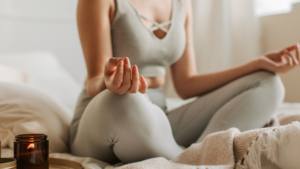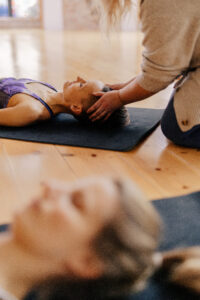
How to balance your hormones with hormone yoga
Do you feel out of balance , have to struggle with mood fluctuations or do you have for no apparent reason ? hormones may be . But before you have to put up with a permanent hormonal imbalance , there is a natural, proven method that can help you: hormone yoga .
This special yoga form combines classic postures with targeted breathing and energy techniques to support your hormone system. Regardless of whether you suffer from thyroid problems, menopause or stress-related hormonal fluctuations- hormone yoga can help you find new energy and inner balance.
In this article you will learn what hormone yoga is, which hormones are addressed and how you integrate into your everyday life . You will also receive instructions for effective exercises and breathing techniques with which you specifically promote your hormonal balance .
What is hormone yoga?
Hormone yoga is a special yoga shape that aims at activating and regulating the endocrine system . developed by the Brazilian yoga teacher Dinah Rodrigues. The method combines classic hatha yoga exercises with dynamic breathing techniques and energetic movements.
aim is to stimulate certain glands such as the thyroid gland, the ovaries and adrenal glands and to promote their hormone production.
Advantages of hormone yoga
- Relief of symptoms of menopause such as hot flashes and mood swings
- Regulation of the menstrual cycle
- Support of fertility
- Increase in the energy level
- Reduction of stress and inner tension
- Promotion of general well -being
- Improvement of sleep and mood through influence on serotonin, dopamine and melatonin
Differences to classic yoga
- Focus on hormone -producing glands
- Combination of static attitudes with dynamic movements
- Targeted breathing techniques to stimulate the hormone system
- Fixed exercise sequences, especially geared towards hormonal balance
- Often shorter, but more intensive exercise units (30 to 45 minutes)
The most important hormones and their connection to the hormone yoga
Cortisol - the stress hormone
Through regular practice, hormone yoga lower the cortisol level and thus contribute to hormonal balance, since relaxation techniques, such as those used yoga support the body in dealing with stressful situations more relaxed and finding inner calm . At the same time, certain breathing exercises and postures promote the activation of the parasympathetic nervous system , which contributes to significantly weakening the stress -causing effect of cortisol.
Thyroid hormones
The thyroid gland stimulates the thyroid and reversing positions in the hormone yoga and can positively influence their function, whereby hormone yoga on both overfunction and under function . In addition, the stress relief funded yoga indirectly contributes to the health of the thyroid gland, since a balanced hormone balance is closely connected to a relaxed nervous system.
Estrogen and progesterone
Hormone yoga can help harmonize irregular cycles and thus contribute to a more balanced female hormone balance , which can also relieved of symptoms in menopause such as hot flashes or irritability . At the same time, the hormonal balance supported by hormone yoga fertility, since physical and emotional well-being are closely linked to the function of the reproduction system.
testosterone
Hormone yoga naturally stimulate testosterone production in men and thus contribute to more energy, vitality and balance, while in women with increased testosterone levels , such as PCOS, it can have a regulating effect and can support the hormonal balance . In addition, the stress reduction favored by hormone yoga general well-being and has a positive effect on libido and stable hormonal balance.
Hormone-regulating yoga exercises
Conversation (for the thyroid gland)
- Shoulder stand: stimulates the thyroid gland, improves blood circulation
- Plow: massages the thyroid gland, helps with stress relief
- Legs on the wall: gentle reverse posture, calms the nervous system
These attitudes stimulate the thyroid gland, promote blood circulation, support the stress relief and overall have a calming effect on the nervous system.
Turntings (for the adrenal glands)
- Turning while sitting (Ardha MatSyendrasana)
- Lying rotation (Jathara Parivartanasana)
- Standing rotation (Parivrtta triconasana)
These attitudes massage the adrenal glands and promote the production of stress -regulating hormones.
Hip opener (for reproductive hormones)
- Butterfly posture (Baddha Konasana)
- Taube (Eka Pada Rajakapotasana)
- Wide prevention while standing (Prasarita Padottanasana)
These attitudes solve emotional tension and promote the flow of energy in the pelvic area.
Prevent (for reducing stress)
- Standing prevention (Uttanasana)
- Sitting prevention (Paschimottanasana)
- Child keeping (Balasana)
These attitudes have a calming effect, help letting go and support the hormonal balance of stress reduction.
Breathing techniques for hormone regulation
Exchange breathing (Nadi Shodhana)
- Soothes the nervous system
- Sinks cortisol
- Supports hormone production by improved blood flow to the glands
- Ideal for daily practice, about 5–10 minutes
Cooling breath (Sitali Pranayama)
- Effective in hot flashes and inner heat
- Has a balancing effect on the estrogen level
- Reduces nervousness and emotional unrest
Invigorating breath (Bhastika)
- Activates the thyroid gland
- Promotes the metabolism
- Increases the oxygen supply
- Helpful for energy and drive weakness
If you want to deal with breathing exercises (pranayama) , then try it out with us! Find the right class for you.
Further forms of movement to support your hormones
In addition to hormone yog A, other forms of movement can also positively influence the . Light endurance training such as swimming or cycling strengthens the cardiovascular system and promotes stress relief . Strength training with your own body weight and martial arts (e.g. kickboxing , boxing or taekwondo ) supports muscle building and metabolic activity. Pilates specifically strengthens the middle of the body and improves posture. Walks in nature have a calming effect, promote vitamin D production and contribute to mental balance.
If you cardio combined with strength , we recommend the following courses in the Mindful Life Berlin:
Ready for more lightness, energy and happiness through hormone yoga?
Then be with our Special Class: " Glow & Flow - activate your happiness hormones with Yin Yoga and simple hacks" .
This special unit combines gently yoga with effective tools to wake up your happiness hormones and strengthen your inner balance.
Conclusion
Hormone yoga is an effective, natural way to balance your hormone system. Through targeted yoga exercises, breathing techniques (pranayama) and healthy lifestyle, you can regulate important hormones and significantly improve your physical and mental well -being.
It is best to start with a few exercises and breathing techniques that you practice regularly. The key lies in continuity - if you practice regularly, you will soon feel positive effects on energy, mood and health
Use the power of the hormone yoga to find your inner balance again and to promote your health holistically.
Sources
- https://www.yogaeasy.de/artikel/hormon-yoga effect
- https://ognx.com/blogs/journal/alles-uber-hormon-yoga-ache-und-ziele?srsrsLTID=AFMBOOPPGHFXYSSA0CO4FXWK0HUVRMK1RWYI2NIQ9B25WLPYVHUIS
- https://www.einfachganzleben.de/meditation-achtamheit/hormon-yoga
- https://www.lotuscrafts.com/blog/hormon-yoga-uebungungen?srsrsltid=afmbooptttQzbnix647dmde3n0yjfkvix64doozgwd92026WQE8VM7XY0
- https://ovularing.com/blog/was-ist-iert-hormonyoga/
- https://www.lotusmonyoga.ca/about-dinah-rodrigues.html
- https://laufmamalauf.de/hormonbalance-auf-demter-besten-besten-fuer-jede-cycle phase/#:text=proteinreichen%20-Zeiwei%9Fe%20-Von%20insulin%20Leptin%20Sind.





